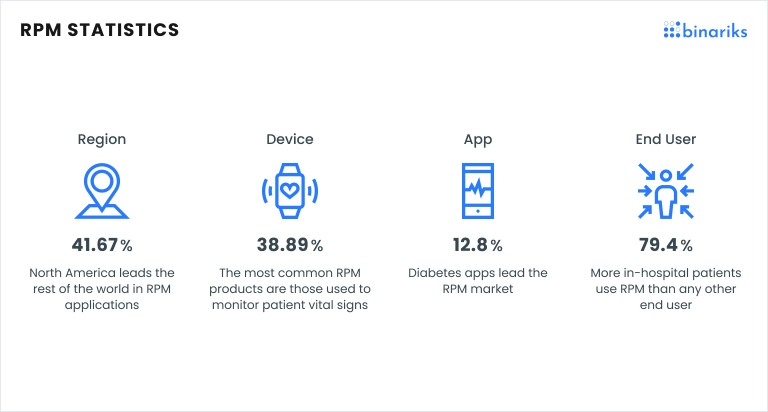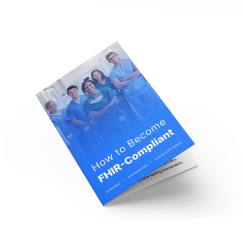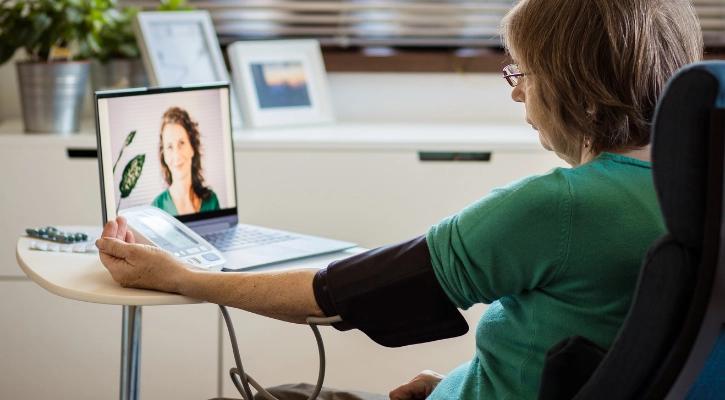This comprehensive guide delves into the dynamic world of healthcare technology, exploring the convergence of telemedicine and remote patient monitoring.
A better understanding of telemedicine and remote patient monitoring practices can help healthcare professionals and organizations optimize virtual care and elevate patient outcomes. So, in this article, we will talk about RPM and telemedicine integration, benefits, applications of these technologies, and the most common implementation challenges. Let's start from the very beginning.
Is remote patient monitoring considered telemedicine?
The short answer is – in a sense, yes. Talking about remote patient monitoring VS telemedicine, it's worth mentioning that they both play crucial roles in improving healthcare delivery but serve distinct purposes.
Telemedicine refers to the virtual delivery of healthcare services, including consultations, diagnosis, and treatment by using telecommunication technologies. It facilitates real-time interactions between healthcare providers and patients, bridging geographical barriers and enhancing access to medical care.
However, medical practitioners need precise data regarding their patient's health status to make the most of telemedicine consultations. And here, remote patient monitoring comes into play.
Through RPM, healthcare providers can effectively cater to individuals dealing with either chronic conditions or acute illness in real time. This is achieved through connected devices, like sensors, wearables, and other digital tools, that continuously transmit long-term data. The accumulated information serves as valuable input for telemedicine sessions and also aids healthcare professionals in ensuring patients' adherence to recommended protocols, all without in-person appointments.

Remote patient monitoring, telehealth, telemedicine, e-care – numerous terms surrounding the digital health industry can be a common source of confusion. Moreover, a synonymous understanding of telehealth and telemedicine is increasingly found. Yet typically, both telemedicine and RPM are considered a subset of telehealth, which refers to a broader scope of remote healthcare service.
In essence, telemedicine and RPM can be used independently, though in some cases, RPM can complement telemedicine. As remote patient monitoring software development practices, processes, and tools evolve, seamless integration of telemedicine and RPM becomes more achievable. This combination presents a holistic approach to patient-centered care, ensuring enhanced health outcomes and improved healthcare accessibility.
The growing significance of telemedicine and RPM
The development of telehealth, and RPM and telemedicine in particular, have sparked a transformation in the healthcare landscape, greatly improving the way medical services are delivered and received. Together, these technologies present a powerful combination that brings forth numerous advantages.
Enhanced accessibility
By leveraging telecommunication technologies and wearable devices, patients can connect with healthcare providers regardless of their physical location. This capability is especially critical for individuals residing in remote or underserved areas, where access to medical specialists might be limited.
Telehealth bridges this gap, granting patients the opportunity to receive timely and expert care from the comfort of their homes.
Real-time monitoring
One of the key strengths of these technologies is the ability to monitor patients in real time. With the continuous collection and transmission of vital health data, healthcare providers can closely track patients' conditions, promptly detect any concerning trends, and intervene before potential health issues escalate.
This proactive approach to patient care can significantly reduce hospital readmissions and emergency visits, leading to improved patient health management and better resource utilization.
Cost-effectiveness
Telemedicine and RPM offer cost-effective alternatives to traditional in-person medical consultations. By minimizing physical appointments and hospital visits, patients can avoid transportation costs and lost wages due to time off from work.
Along with that, healthcare facilities can optimize their resources and allocate medical personnel more efficiently. The reduction in non-urgent emergency room visits and hospitalizations can also alleviate the burden on healthcare systems and lower overall healthcare costs.

Convenience and flexibility
The combination of telemedicine and remote patient monitoring brings unparalleled convenience and flexibility to both patients and healthcare workers.
Patients can schedule virtual consultations at their convenience, avoiding long wait times and crowded waiting rooms. For patients with chronic conditions, RPM allows them to maintain their regular activities while still being closely monitored by medical professionals.
And healthcare providers can also enjoy greater flexibility in managing their schedules, offering virtual visits and continuous monitoring in a more streamlined manner.
In short, using remote patient monitoring with telemedicine services empowers patients to take charge of their health and enables healthcare providers to deliver more efficient, proactive, and patient-centered care.
Build compliant and secure RPM apps with healthcare software engineering experts
How to use RPM with telemedicine
Real-life scenarios they are used
Using some form of telehealth and remote patient monitoring brings immense value to various real-life healthcare scenarios, enabling seamless care delivery and continuous health monitoring. Some of the key scenarios where these technologies are used include:
- Chronic disease management: Telemedicine and RPM play a pivotal role in managing chronic diseases by providing healthcare professionals real-time insights into patients' health status. Continuous monitoring allows for early detection of fluctuations in vital signs and symptoms, enabling timely interventions and personalized care plans.
- Post-operative care: Following surgical procedures, patients often require careful monitoring to ensure a successful recovery and detect potential complications. RPM devices enable healthcare providers to track patients' progress and any changes in symptoms, and identify early signs of patient deterioration that may require immediate intervention.
- Mental health support: Telehealth and RPM have proved instrumental in supporting mental health patients, offering remote counseling sessions and continuous emotional well-being monitoring. These technologies improve accessibility to mental health services and enhance patient engagement and support.
US Nationwide Poll held in May 2021 shows an Increased Popularity for telehealth services.

Symptoms & conditions
Remote patient monitoring and telemedicine cover a wide range of symptoms and conditions, including but not limited to:
- High blood pressure
- Diabetes
- Weight loss or gain
- Heart conditions
- Chronic obstructive pulmonary disease (COPD)
- Sleep apnea
- Asthma
- Chronic pain management
- Anxiety and depression
RPM devices
An array of innovative RPM devices facilitates the collection and transmission of patient health data. These devices empower patients to actively participate in their care while ensuring healthcare providers receive accurate and timely information.
- Weight scales: Monitor weight fluctuations and trends, essential for weight management and chronic disease monitoring.
- Pulse oximeters: Measure oxygen saturation levels in the blood, crucial for assessing respiratory health and oxygenation.
- Blood glucose meters: Track blood sugar levels for effective diabetes management and insulin dosage adjustments.
- Blood pressure monitors: Monitor blood pressure trends to prevent hypertension-related complications.
- Smartwatches and fitness trackers: Track various health metrics, including heart rate, physical activity, and sleep patterns, providing insights into overall well-being.

By leveraging all the data, healthcare providers can tailor treatment plans to individual needs, improve patient engagement, and achieve better health outcomes for a wide range of medical conditions. Check out this article about RPM devices for more details and explanations.
Real cases & examples
Remote patient monitoring and telemedicine VS the COVID-19 pandemic
The study from September 2021 was held to check whether RPM and telemedicine can improve COVID-19 patient outcomes. Daily text message surveys and telemedicine consultations were offered to all patients who tested positive for SARS-CoV-2 at institutional screening centers.
Survey respondents with alarm responses were contacted by a nurse. The relationship between virtual engagement (telemedicine or RPM survey response) and clinical outcomes we assessed using multivariable logistic regression (source ).
Between 10 July 2020 and 2 January 2021, 6822 patients tested positive, with 1230 (18%) responding to at least one survey. Compared with non-responders, responders had fewer comorbidities. Individuals who engaged virtually were less likely to experience an emergency department visit, hospital admission, or intensive care unit-level care.
Digital inhalers and remote patient monitoring for asthma
Digital inhaler systems, remote patient monitoring, and telehealth are also used in managing difficult-to-control asthma. Digital inhaler systems equipped with RPM technology can objectively track medication adherence and inhaler technique in real-time, transmitting data to mobile asthma apps and clinician dashboards. Telehealth complements RPM by enabling remote patient-provider interactions, allowing personalized feedback and counseling during virtual consultations (source ).
The studies showed that RPM provided accurate insights into medication adherence and inhaler technique, surpassing traditional methods. Patients receiving feedback during telehealth consultations exhibited improved adherence and technique, leading to reduced asthma exacerbations and lower reliance on high side effect treatments and costly therapies. Patient-provider communication was enhanced, and patients felt more engaged in their asthma management.
RPM and telemedicine for health plans and HIPAA regulations
Under the supervision of Dr. Madrid, Medical Director of Rancho Family Medical Group (RFMG) in Temecula, CA, RPM and telehealth solutions were implemented for over 1000 patients. The program aimed to address non-compliance with health plans and HIPAA regulations due to communication challenges with patients.
Targeting five senior couples, medical devices were provided for vital signs measurements at home. After some initial hurdles, adjustments were made to improve technology and human interaction using wellness coaching techniques (source ).
The RPM program resulted in a significant reduction in readmission rates, with RFMG presenting a rate lower than 10% during the pilot program. This indicated successful proactive interventions, reducing costly ER visits and readmissions in 90% of the studied patients.
Want to become HIPAA-compliant?
Learn about best practices of FHIR implementation.

Challenges and best practices
Different examples of remote patient monitoring, telemedicine, and other telehealth solutions often present similar challenges for healthcare organizations that implement them. Some of these include:
- Technology integration: Integrating RPM devices and telemedicine platforms with existing healthcare systems can be complex and require seamless data exchange.
- Data security and privacy: Ensuring the security and privacy of patient-generated health data is crucial, as healthcare data is highly sensitive and subject to HIPAA regulations.
- Patient engagement: Encouraging patients, especially seniors, to adopt and effectively use RPM devices and telemedicine platforms can be a challenge, requiring proper education and support.
- Reimbursement and funding: Navigating reimbursement policies and securing funding for RPM and telemedicine initiatives can pose financial challenges for healthcare providers.
As a tech partner, Binariks can assist healthcare organizations in implementing RPM and telemedicine solutions. With a team of skilled experts, we offer comprehensive technology expertise, seamlessly integrating RPM devices and telemedicine platforms into existing healthcare systems. Data security and privacy are at the forefront of our approach, ensuring strict adherence to industry best practices and compliance with HIPAA regulations.
Transform your healthcare organization with Binariks' cutting-edge services and solutions. Contact us today to provide personalized and efficient care while achieving cost savings.
Using other technologies in telemedicine and RPM
There are a lot of innovative technologies that can be applied when implementing telemedicine and RPM, complementing and improving these care delivery methods.
Blockchain
The blockchain role in telehealth and remote patient monitoring is to ensure data security and privacy in different applications. With its decentralized and tamper-resistant nature, blockchain offers a secure platform for storing and sharing patient health records. This not only enhances data security but also enables seamless data exchange between healthcare providers, improving the efficiency of telemedicine consultations and RPM monitoring.
Artificial intelligence
AI algorithms can analyze vast amounts of patient data, detect patterns, and provide valuable insights to healthcare professionals. By leveraging AI-driven analytics , healthcare providers can make accurate and informed decisions, leading to early detection of health issues and personalized treatment plans.
AI-powered virtual assistants and chatbots can also enhance patient engagement and support, providing real-time assistance and medical advice to patients.
Wearable devices and the Internet of Things
Wearable devices such as smartwatches, fitness bands, and remote monitoring sensors enable patients to collect and transmit real-time health data to healthcare providers.
IoT connectivity enables seamless integration of these devices into telehealth platforms, facilitating continuous monitoring and proactive interventions.
The integration of these technologies offers a transformative vision for the future of telemedicine or remote patient monitoring, empowering both providers and patients with advanced tools and insights for better health management.
Final thoughts
By combining real-time data collection and RPM analytic features with the virtual consultation capabilities of telemedicine, healthcare providers can deliver more efficient, proactive, and patient-centered care.
The seamless integration of telemedicine and RPM has numerous advantages, including enhanced accessibility, real-time monitoring, cost-effectiveness, convenience, and flexibility. These technologies have many areas of application, including chronic disease management, post-operative care, and mental health support.
As the healthcare landscape continues to evolve, telemedicine and remote patient monitoring will play an increasingly important role in delivering high-quality, accessible, and affordable care to patients worldwide.
FAQ
Share

